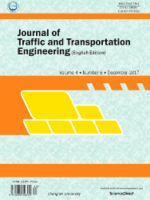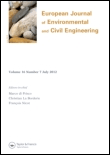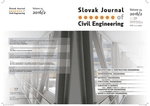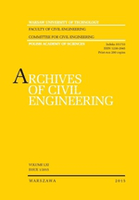
CIVIL ENGINEERING
Scope & Guideline
Bridging Knowledge and Practice in Civil Engineering
Introduction
Aims and Scopes
- Structural Engineering:
Focuses on the analysis, design, and performance evaluation of structures including buildings, bridges, and dams, with an emphasis on seismic resilience and innovative materials. - Transportation Engineering:
Covers topics related to traffic flow, road safety, and the optimization of transportation systems, integrating advancements in AI and data analytics for improved infrastructure management. - Environmental Engineering:
Addresses issues such as water quality, waste management, and the impact of climate change on civil infrastructure, promoting sustainable solutions for environmental challenges. - Geotechnical Engineering:
Explores soil-structure interactions, foundation design, and the behavior of materials under load, with studies often focusing on innovative materials and methods. - Construction Management:
Includes research on project delivery methods, risk assessment, and the optimization of construction processes, highlighting the role of technology in enhancing productivity and safety. - Materials Engineering:
Investigates the properties and applications of construction materials, including the use of recycled and sustainable materials, alongside advancements in material science.
Trending and Emerging
- Sustainable Construction Practices:
Increasing attention is being paid to sustainable materials and practices, with research exploring the use of recycled materials and environmentally friendly construction techniques. - Smart Infrastructure and IoT:
The integration of Internet of Things (IoT) technologies into civil engineering is gaining prominence, with studies examining smart sensors and data analytics for infrastructure monitoring and management. - Climate Resilience and Adaptation:
Research focusing on the resilience of infrastructure to climate change impacts, including flooding and extreme weather events, is becoming increasingly relevant as environmental concerns grow. - Advanced Data Analytics in Engineering:
The use of machine learning and AI for predictive analytics, condition monitoring, and optimization in civil engineering practices is emerging as a significant area of interest. - BIM and Digital Construction Technologies:
Building Information Modeling (BIM) and other digital technologies are increasingly being explored for their role in enhancing project efficiency, collaboration, and lifecycle management. - Innovative Materials and Technologies:
Research into new construction materials, including nanomaterials and bio-based materials, is trending, reflecting a shift towards innovation in material science.
Declining or Waning
- Traditional Construction Techniques:
There is a noticeable reduction in research focused on conventional construction methods as newer, more innovative techniques and materials gain traction in the field. - Basic Infrastructure Maintenance:
Research specifically dedicated to conventional maintenance practices has diminished, likely due to the industry's shift towards more advanced predictive maintenance technologies and data-driven management. - Non-automated Traffic Management:
Studies related to traditional traffic management systems have decreased in favor of research exploring automated and smart traffic systems, reflecting evolving transportation technology. - Static Structural Analysis:
The emphasis on basic static analysis methods has waned as more complex and dynamic modeling approaches become standard in structural engineering research. - Purely Theoretical Studies:
There is a decline in the publication of papers that focus solely on theoretical frameworks without practical applications, as the journal increasingly favors applied research that demonstrates real-world relevance.
Similar Journals

Teknik Dergi
Building Knowledge, Shaping FuturesTeknik Dergi is a key academic journal published by the Turkish Chamber of Civil Engineers, focusing on the critical fields of Building and Construction as well as Civil and Structural Engineering. Established in Turkey, this journal serves as a vital platform for researchers, practitioners, and students to disseminate innovative findings and advancements within these disciplines. Although its coverage in databases like Scopus has been discontinued since 2022, Teknik Dergi remains a respected resource for its historical contributions, with a record of publication spanning from 1990 to 1998 and then from 2002 to 2022. The journal currently holds a Q4 categorization in both its primary fields, ranking within the 30th and 25th percentiles respectively. Authors and readers can access articles exploring practical applications and theoretical foundations, making it a valuable asset for those engaged in the rapidly evolving landscape of civil engineering. Open Access options are also available, allowing for broader dissemination and engagement with its published work.

Journal of Traffic and Transportation Engineering-English Edition
Pioneering Research for the Future of Transportation.Journal of Traffic and Transportation Engineering-English Edition, published by KEAI PUBLISHING LTD, is a leading open-access journal that has been disseminating valuable research in the realms of civil and structural engineering, as well as transportation studies since 2014. With a robust impact factor reflected by its prestigious Q1 rankings in both Civil and Structural Engineering and Transportation, this journal stands at the forefront of innovation and scholarship, featuring contributions from experts across the globe. The journal is particularly noted for its practical and theoretical advancements in traffic and transportation engineering, making it indispensable for researchers, industry professionals, and students aiming to deepen their understanding of these critical fields. Dedicated to providing a platform for high-quality interdisciplinary research, the Journal of Traffic and Transportation Engineering embraces the principles of open access, ensuring that all published articles are freely available to foster knowledge sharing and collaboration within the community. With its headquarters located in Beijing, China, the journal continues to push boundaries and set new standards in the field of traffic and transportation research.

Periodica Polytechnica-Civil Engineering
Transforming Infrastructure Through Cutting-Edge InsightsPeriodica Polytechnica-Civil Engineering is a prestigious journal published by the Budapest University of Technology and Economics, dedicated to advancing the field of civil engineering through high-quality research and innovative practices. Established in 1972, the journal has transitioned through various phases of publication and now spans an expansive range of topics within civil and structural engineering, geotechnical engineering, and engineering geology. With an impact factor indicating its growing influence and a commendable placement in the Q3 quartile according to the latest 2023 metrics, it recognizes contributions that bridge theoretical advancements with practical applications. While currently not open access, the journal remains a vital resource for researchers, professionals, and students seeking to stay abreast of the latest developments in engineering design, construction techniques, and geotechnical innovations. The continuous publication of significant research after almost five decades underscores its commitment to disseminating knowledge crucial for the world’s infrastructure challenges, making it an essential reference point within the engineering community.

Jordan Journal of Civil Engineering
Building Knowledge, Shaping FuturesThe Jordan Journal of Civil Engineering, ISSN 1993-0461 and E-ISSN 2225-157X, serves as a pivotal platform for research dissemination in the field of civil engineering. Published by Jordan University of Science & Technology, this journal has established itself as a vital resource since its inception in 2007 and continues to impact the academic community with its wide-ranging scope covering innovative practices and cutting-edge research in civil and structural engineering. Holding a respectable Q3 ranking in the 2023 category, with Scopus positioning it at rank #235 out of 379, the journal reflects growing recognition within its discipline. Although currently not an open-access publication, it provides essential insights that can benefit researchers, industry professionals, and students seeking to contribute to advancements in civil engineering through rigorous scholarly articles and studies up to 2024. Its commitment to high academic standards enhances the relevance and importance of its contributions to both local and global engineering practices.

Electronic Journal of the Faculty of Civil Engineering Osijek-e-GFOS
Unlocking Insights for a Sustainable Future in Civil EngineeringWelcome to the Electronic Journal of the Faculty of Civil Engineering Osijek-e-GFOS, a prominent platform dedicated to the dissemination of innovative research in the field of civil engineering. Published by the University of Osijek, this Open Access journal has been accessible to the global academic community since 2010, facilitating the sharing of knowledge and advancements without financial barriers. With an E-ISSN of 1847-8948, the journal aims to cover a broad scope of civil engineering disciplines, including structural engineering, geotechnics, environmental engineering, and construction management, among others. It serves as a crucial resource for researchers, professionals, and students, providing them with insightful articles and studies that contribute to the development of best practices in the field. By promoting open collaboration and knowledge sharing, the Electronic Journal of the Faculty of Civil Engineering Osijek-e-GFOS stands as a testament to the commitment of the University of Osijek to enhance the field of civil engineering through impactful research and educational outreach.

European Journal of Environmental and Civil Engineering
Advancing Sustainable Solutions for a Resilient FutureThe European Journal of Environmental and Civil Engineering, published by Taylor & Francis Ltd, is a prestigious peer-reviewed journal that serves as a vital platform for advancing knowledge in the fields of Civil and Structural Engineering as well as Environmental Engineering. With an impressive impact factor and categorized in the Q2 quartile for both engineering fields, this journal occupies a significant position in the scholarly community. Its focused scope encompasses innovative research, case studies, and practical applications that address contemporary environmental and infrastructural challenges. Researchers, professionals, and students alike benefit from the journal's commitment to high-quality discourse, as evidenced by its Scopus rankings, which place it in the top 30% in Civil and Structural Engineering and the top 40% in Environmental Engineering. Through the publication of cutting-edge studies and a commitment to fostering interdisciplinary dialogue, the European Journal of Environmental and Civil Engineering remains an essential resource for those dedicated to improving our built environment and safeguarding our natural resources.

Slovak Journal of Civil Engineering
Exploring groundbreaking solutions in civil engineering.Welcome to the Slovak Journal of Civil Engineering, a premier open-access publication dedicated to advancing the field of civil engineering. Published by SCIENDO, this journal has been providing a platform for the dissemination of groundbreaking research since 2010, ensuring that all articles are freely accessible to a global audience. With a commitment to promoting innovation and excellence within civil engineering, the journal covers a wide range of topics, including structural engineering, transportation systems, geotechnics, and environmental engineering. The Slovak Journal of Civil Engineering is designed to engage a diverse community of researchers, professionals, and students, fostering collaboration and knowledge-sharing to address contemporary challenges in the field. With its open-access model, the journal not only enhances visibility for authors but also ensures that the latest findings and methodologies reach practitioners and academics alike, making it an essential resource for anyone interested in civil engineering advancements. Stay connected with the evolving landscape of civil engineering through this influential publication.

Turkish Journal of Civil Engineering
Connecting Scholars to Shape the Built EnvironmentWelcome to the Turkish Journal of Civil Engineering, a pioneering publication under the auspices of the TURKISH CHAMBER OF CIVIL ENGINEERS, dedicated to advancing the field of civil engineering and construction. With a focus on cutting-edge research and innovative practices, this journal seeks to provide a platform for scholars, professionals, and students to share their findings and insights within the sphere of civil and structural engineering. The journal is committed to open access, ensuring that research is readily available to a global audience. As it embarks on its journey from 2023 to 2024, it aims to enhance its reputation as a vital resource within the academic community, currently ranking in the 40th percentile for Building and Construction Engineering and 32nd for Civil and Structural Engineering in Scopus. We encourage contributions that push the boundaries of engineering knowledge, fostering collaboration and progress in this essential field.

Infrastructures
Connecting Scholars and Professionals in Engineering ExcellenceInfrastructures is a distinguished open-access journal, published by MDPI since 2016, dedicated to advancing the fields of engineering and construction through interdisciplinary research and critical insights. Based in Switzerland, it serves a global community of scholars and professionals, providing a platform for innovative studies that drive progress in Building and Construction, Civil and Structural Engineering, Computer Science Applications, Geotechnical Engineering and Engineering Geology, and various aspects of Materials Science. With an impressive impact factor and a positioning in the Q2 category across multiple engineering fields, the journal's robust ranking reflects its commitment to high-quality research, with notable Scopus rankings showcasing its significant contribution to academic discourse. Infrastructures not only facilitates open access to essential knowledge but also aims to bridge the gap between theory and practical application, making it an invaluable resource for researchers, industry professionals, and students alike.

Archives of Civil Engineering
Fostering Collaboration in Structural EngineeringArchives of Civil Engineering is a premier academic journal published by POLISH ACAD SCIENCES, dedicated to advancing the field of civil and structural engineering. Established in 1996, this open-access journal has been pivotal in disseminating high-quality research and innovation in engineering practices, particularly since adopting open access in 2010. With an ISSN of 1230-2945 and E-ISSN of 2300-3103, it enjoys a notable reputation, currently ranked in Q3 of the Civil and Structural Engineering category for 2023, reflecting its considerable contribution to scholarly content in the discipline. The journal caters to a diverse audience of researchers, professionals, and students, providing them with a platform to share and access essential findings. Its commitment to high academic standards is underscored by its ranking in Scopus, where it stands at Rank #265/379. Located in Warsaw, Poland, the journal aims to promote international collaboration and foster knowledge exchange in civil engineering, making it an indispensable resource for anyone involved in this dynamic field.